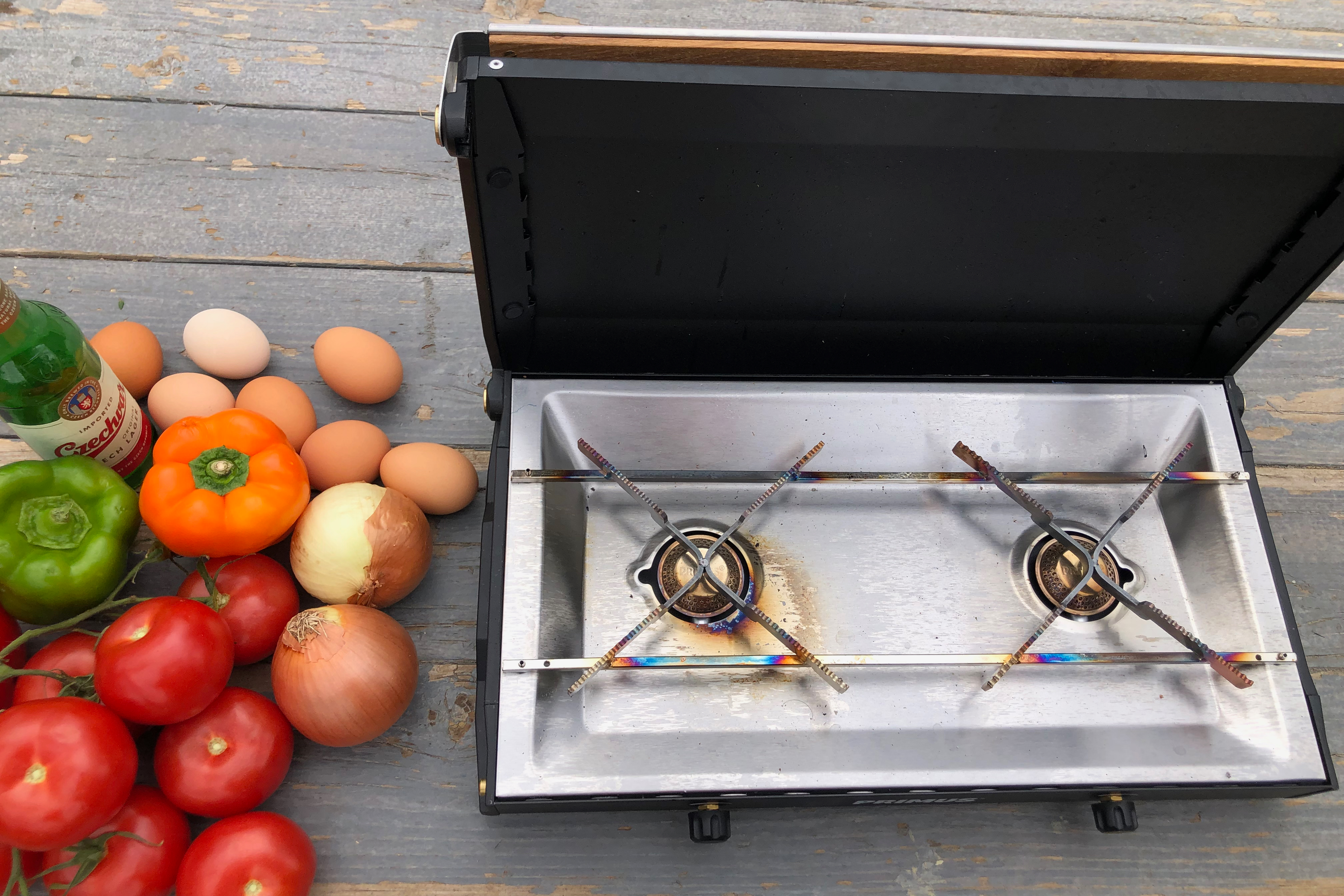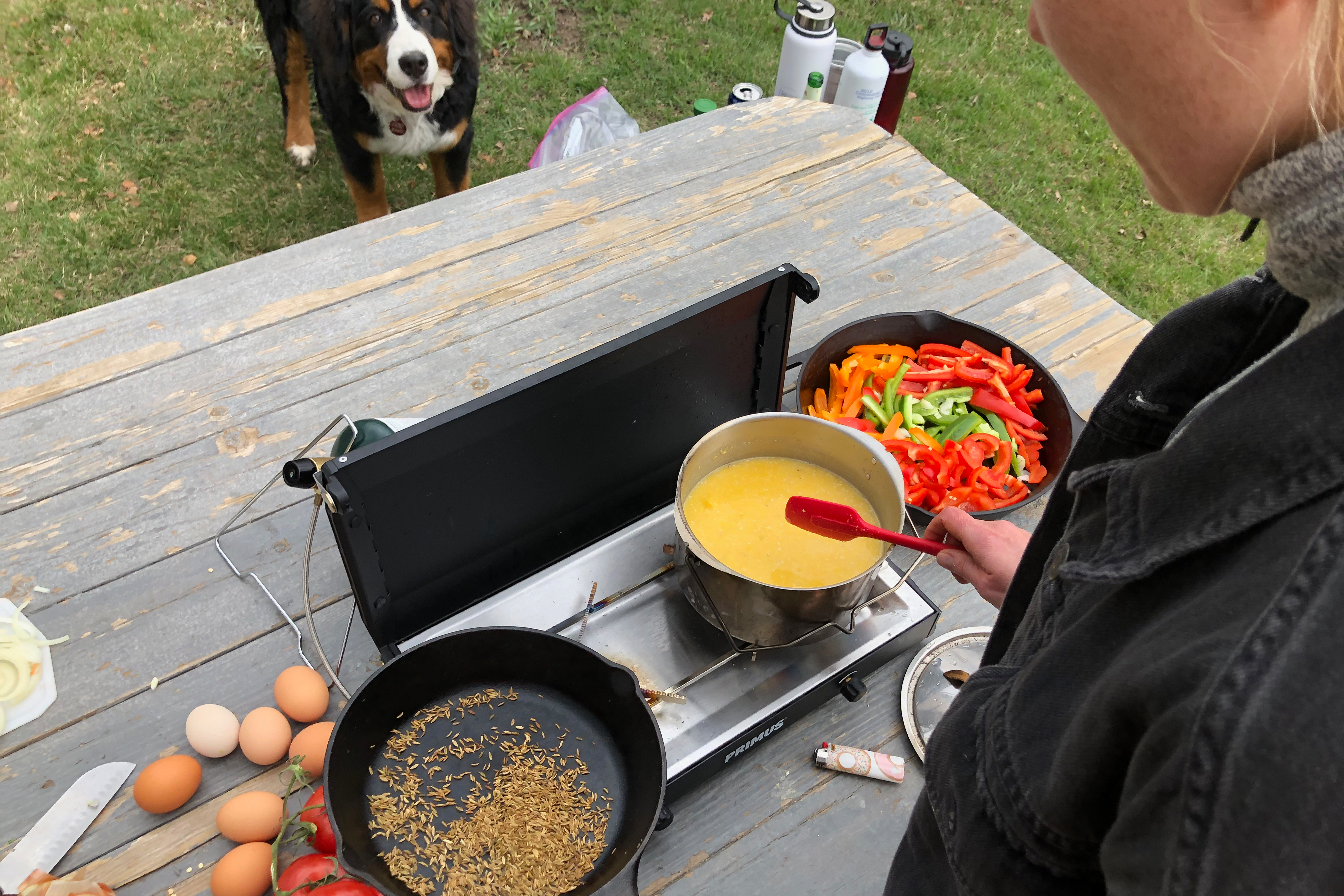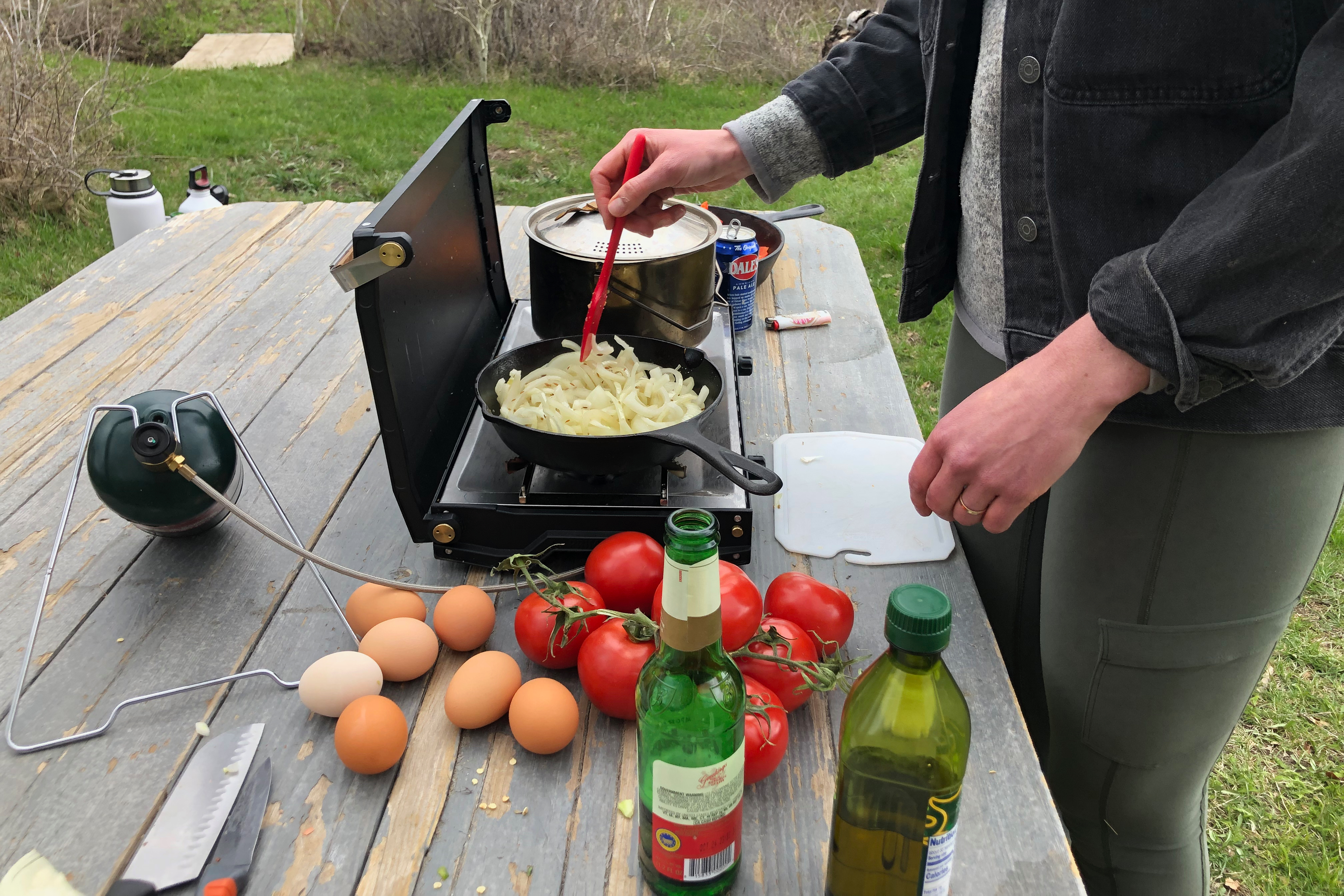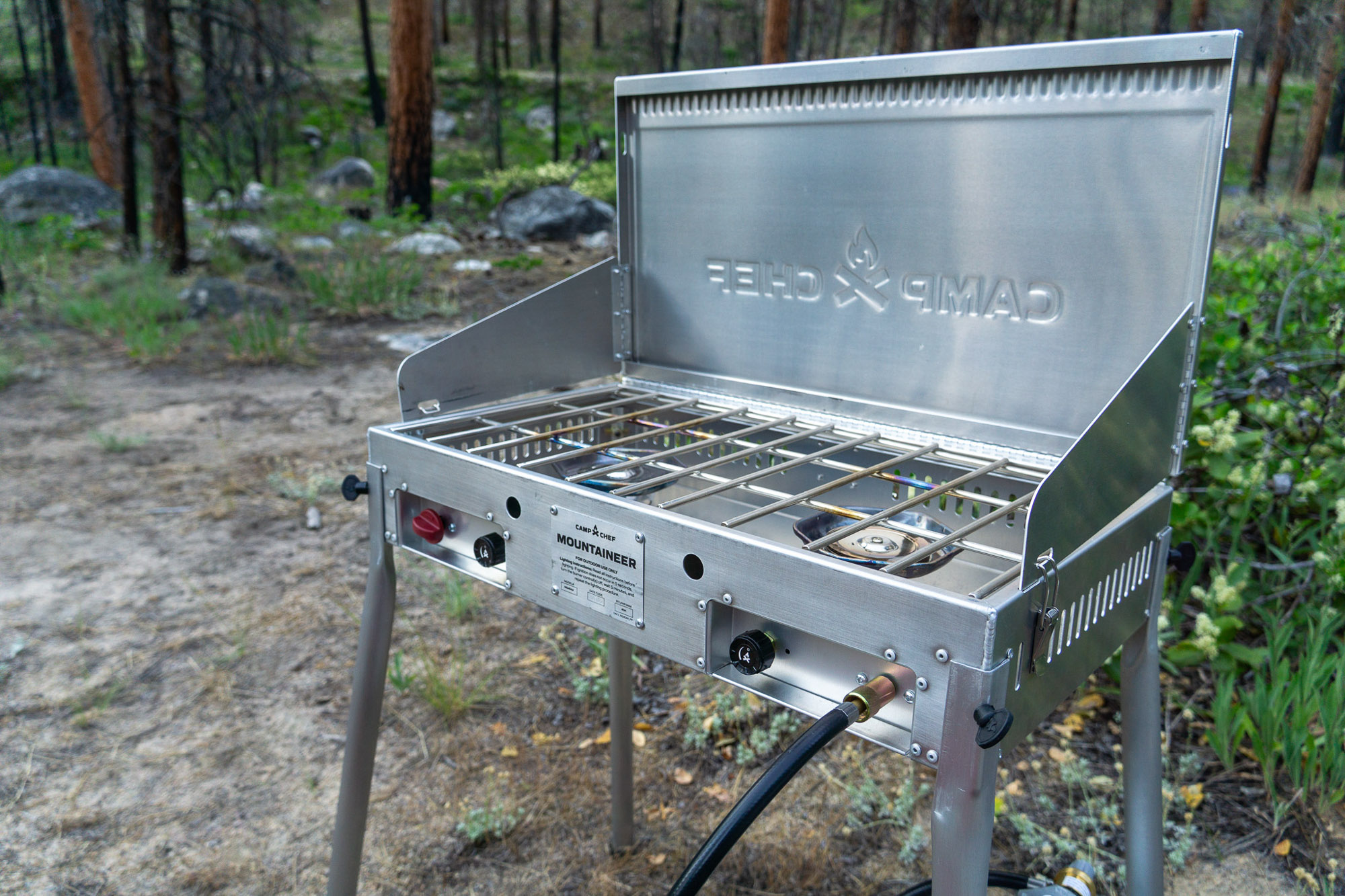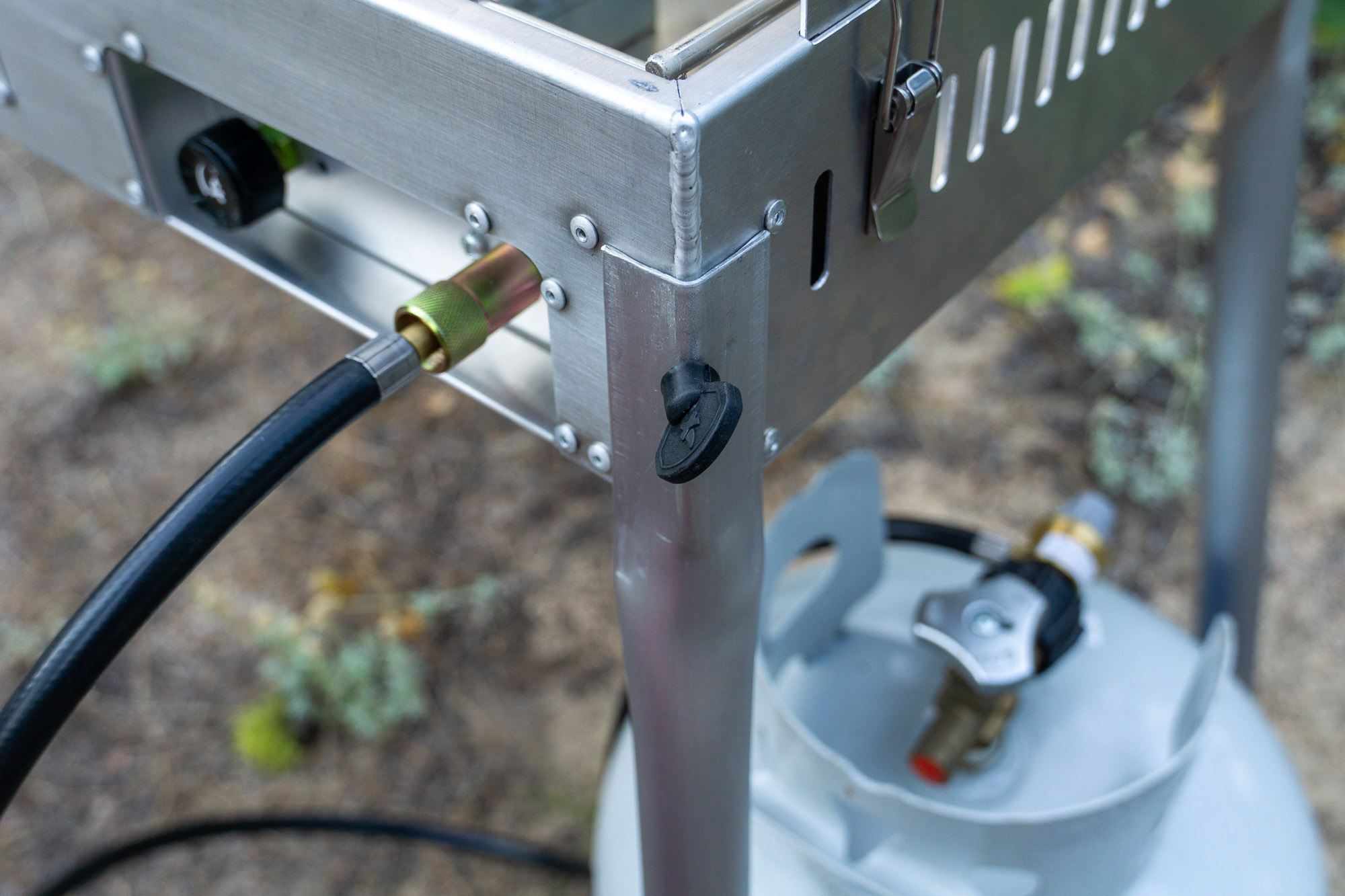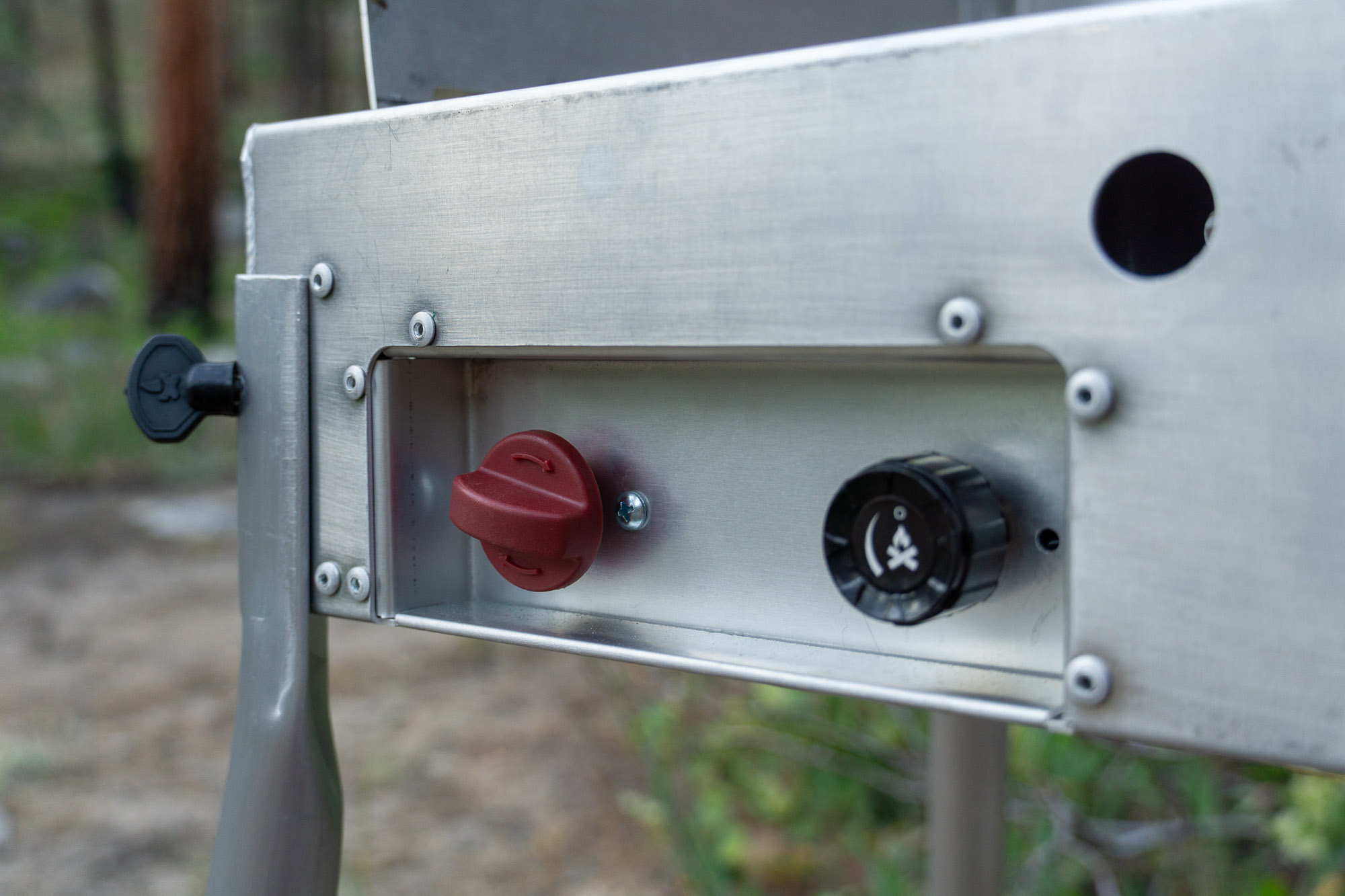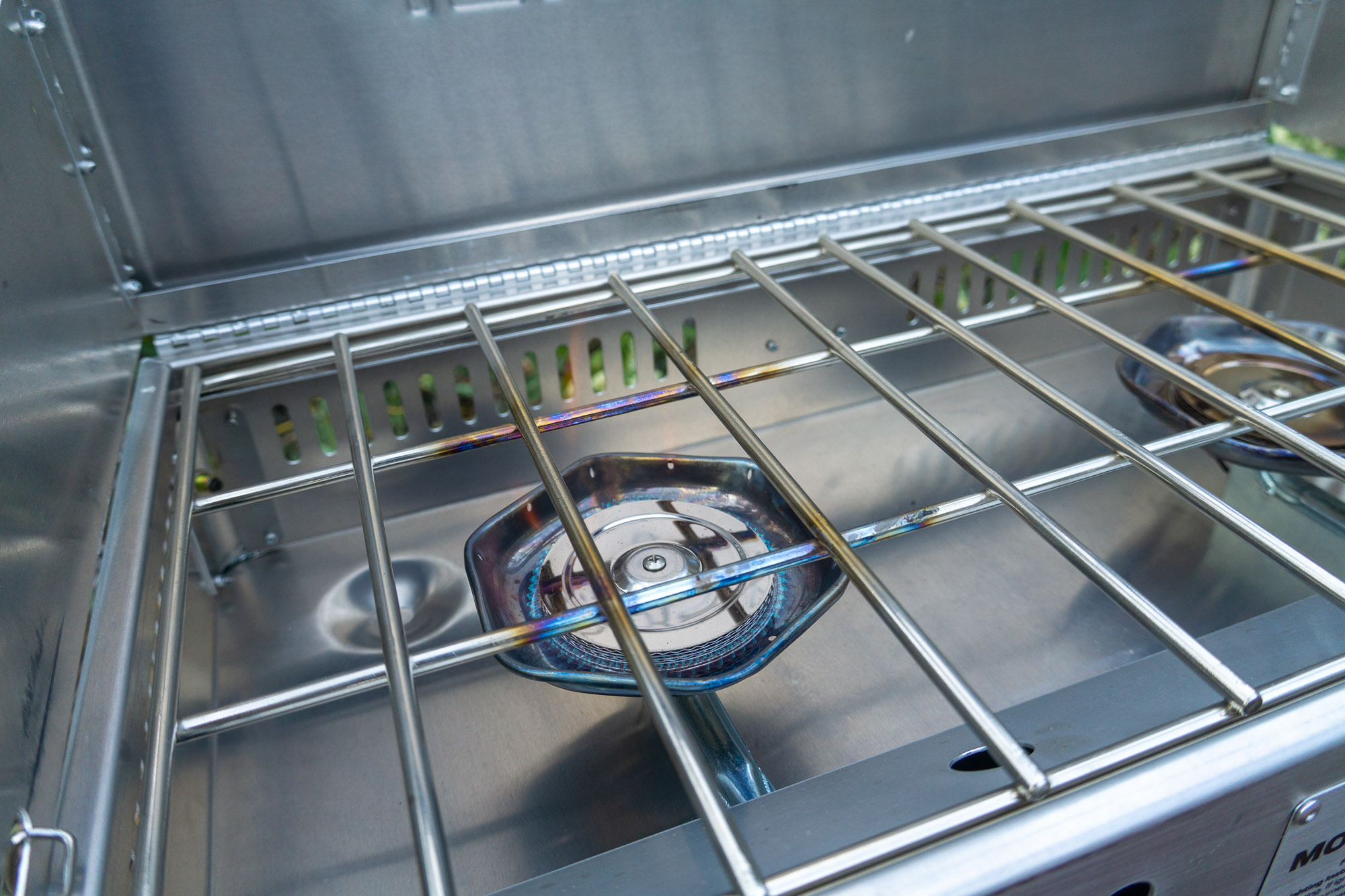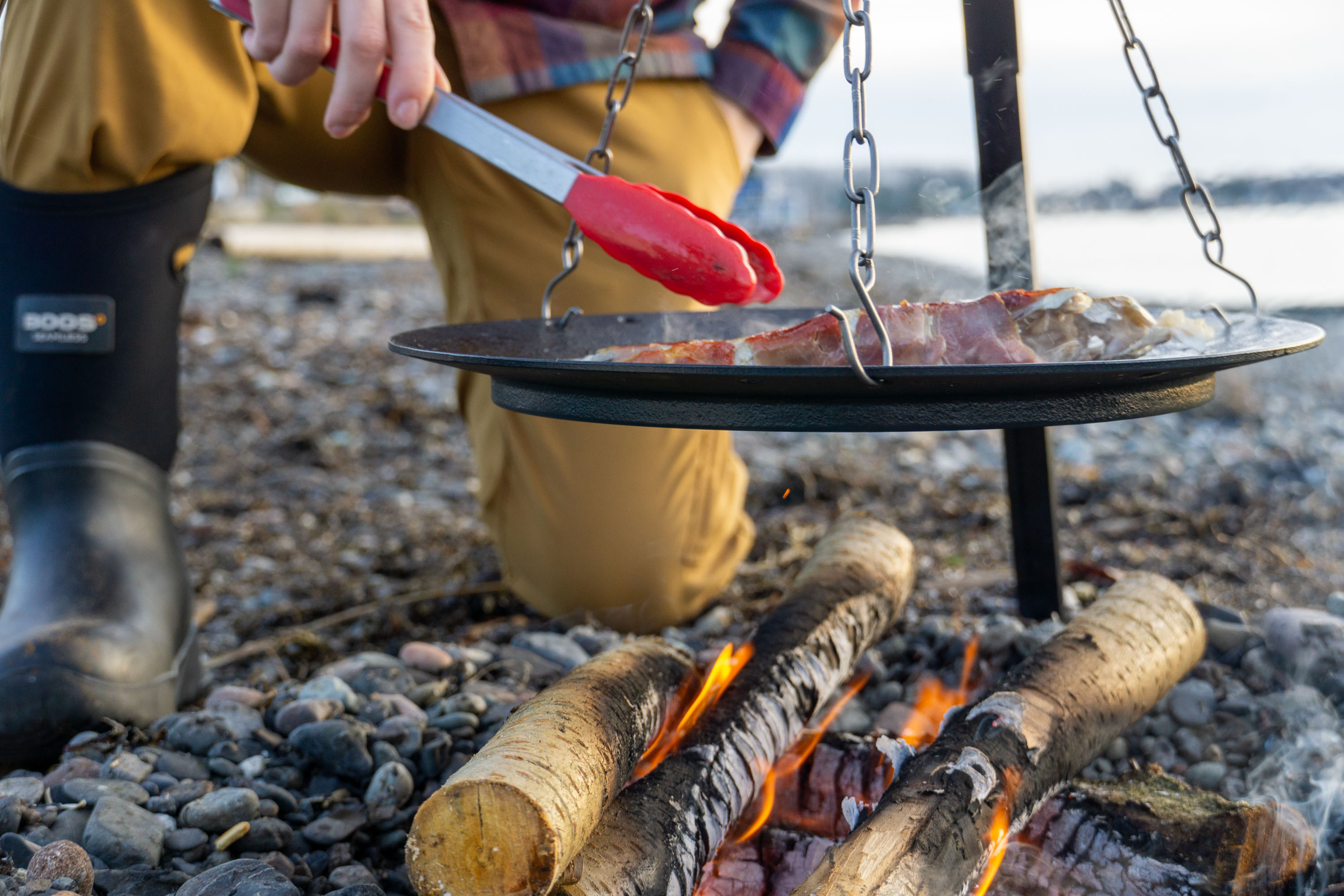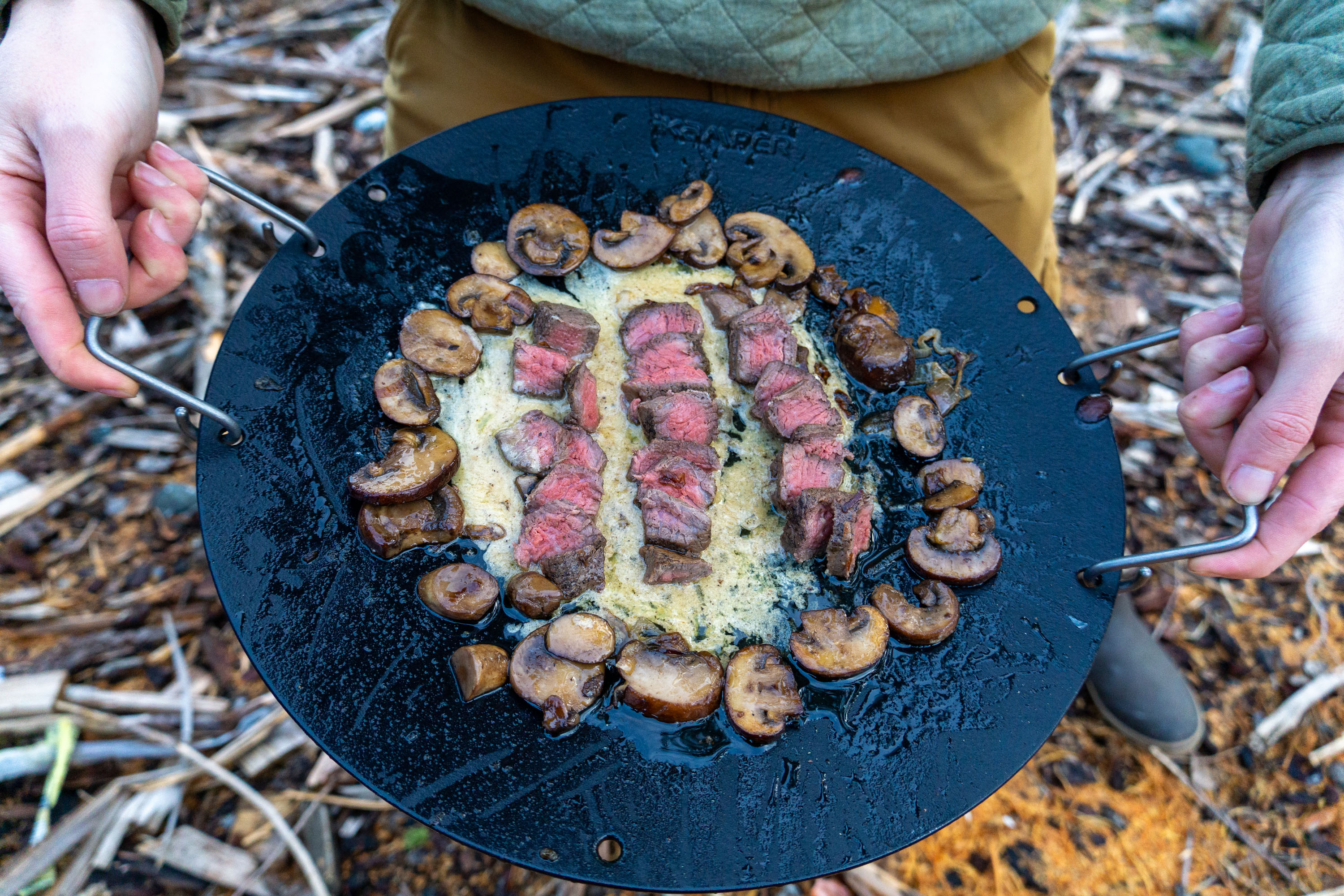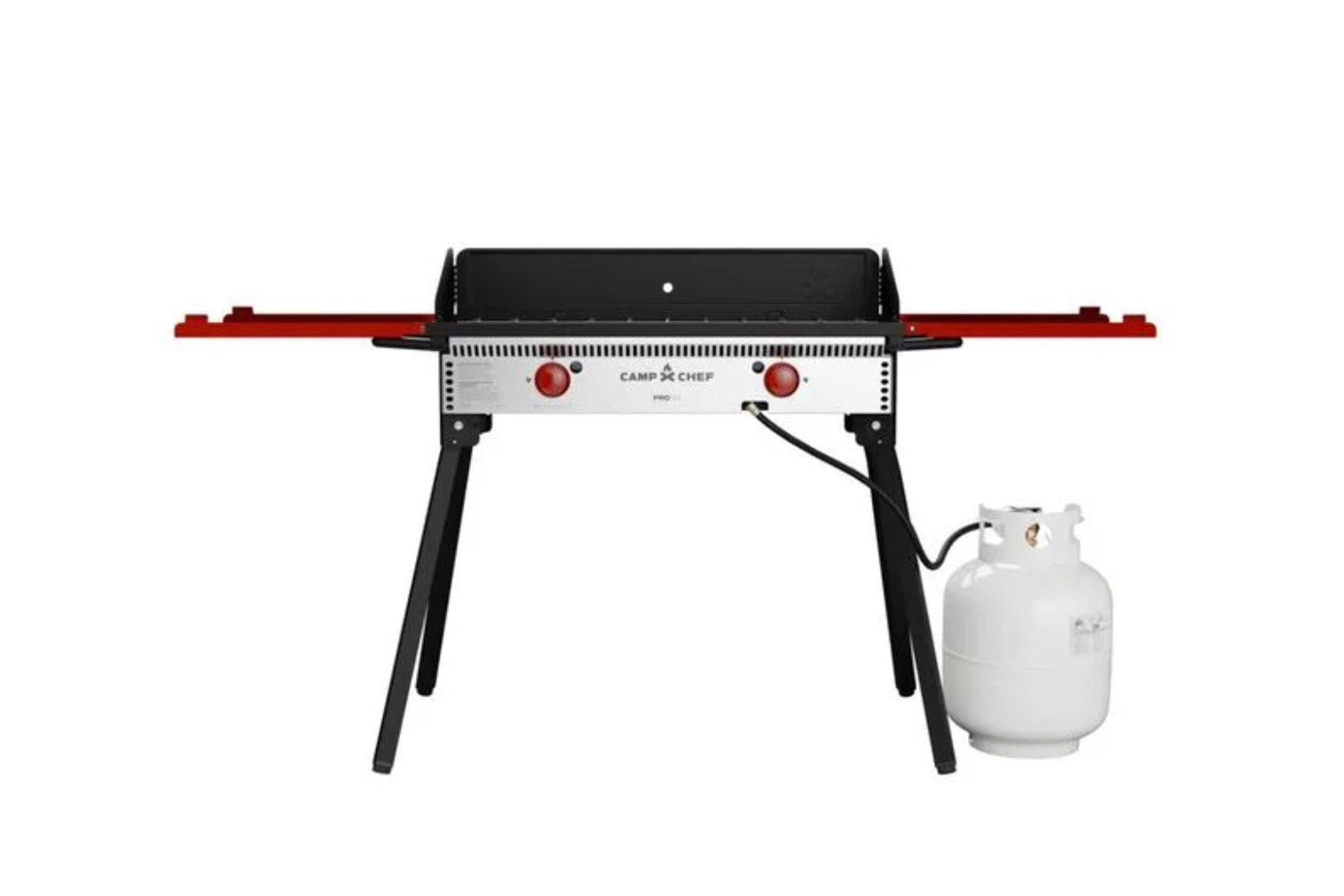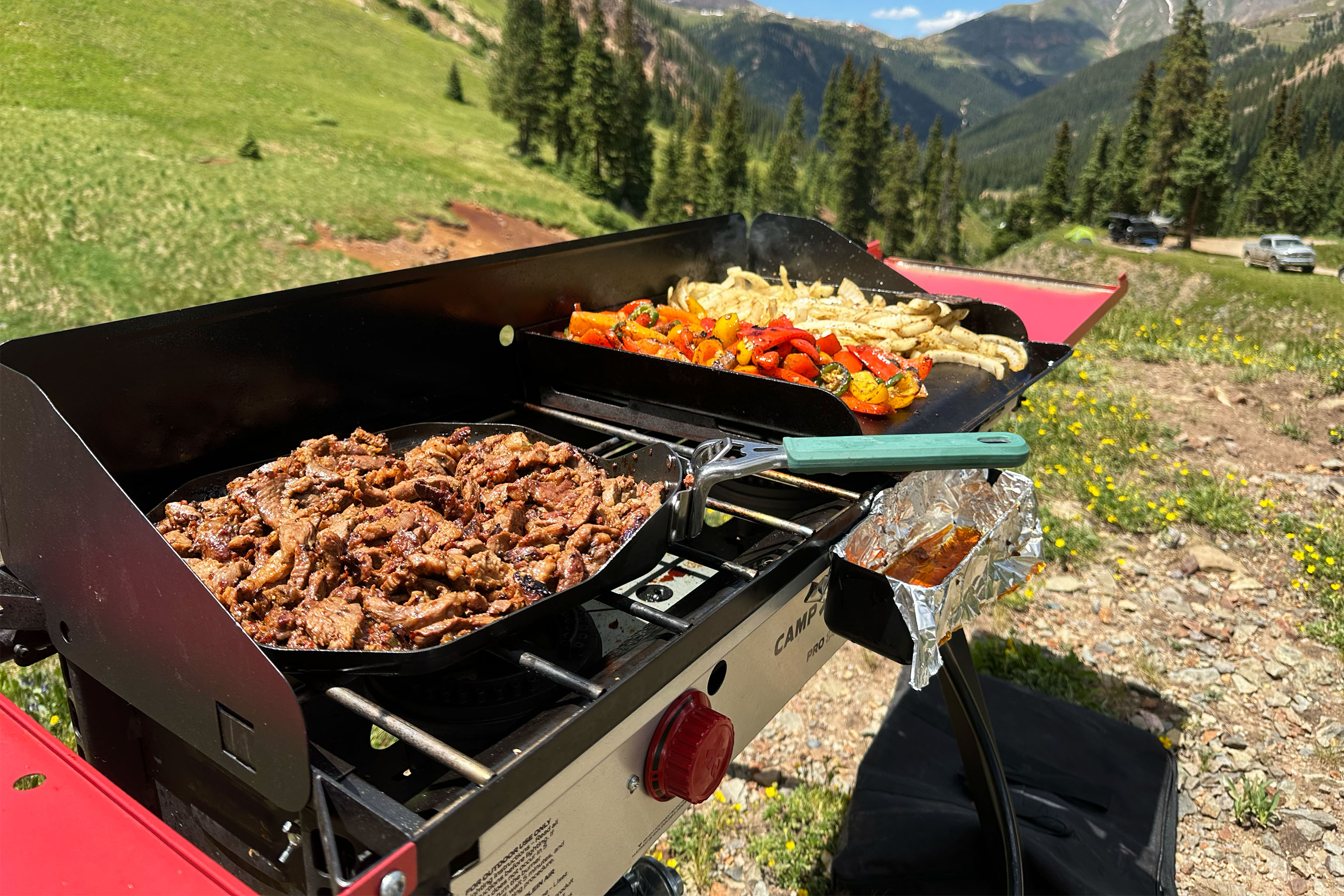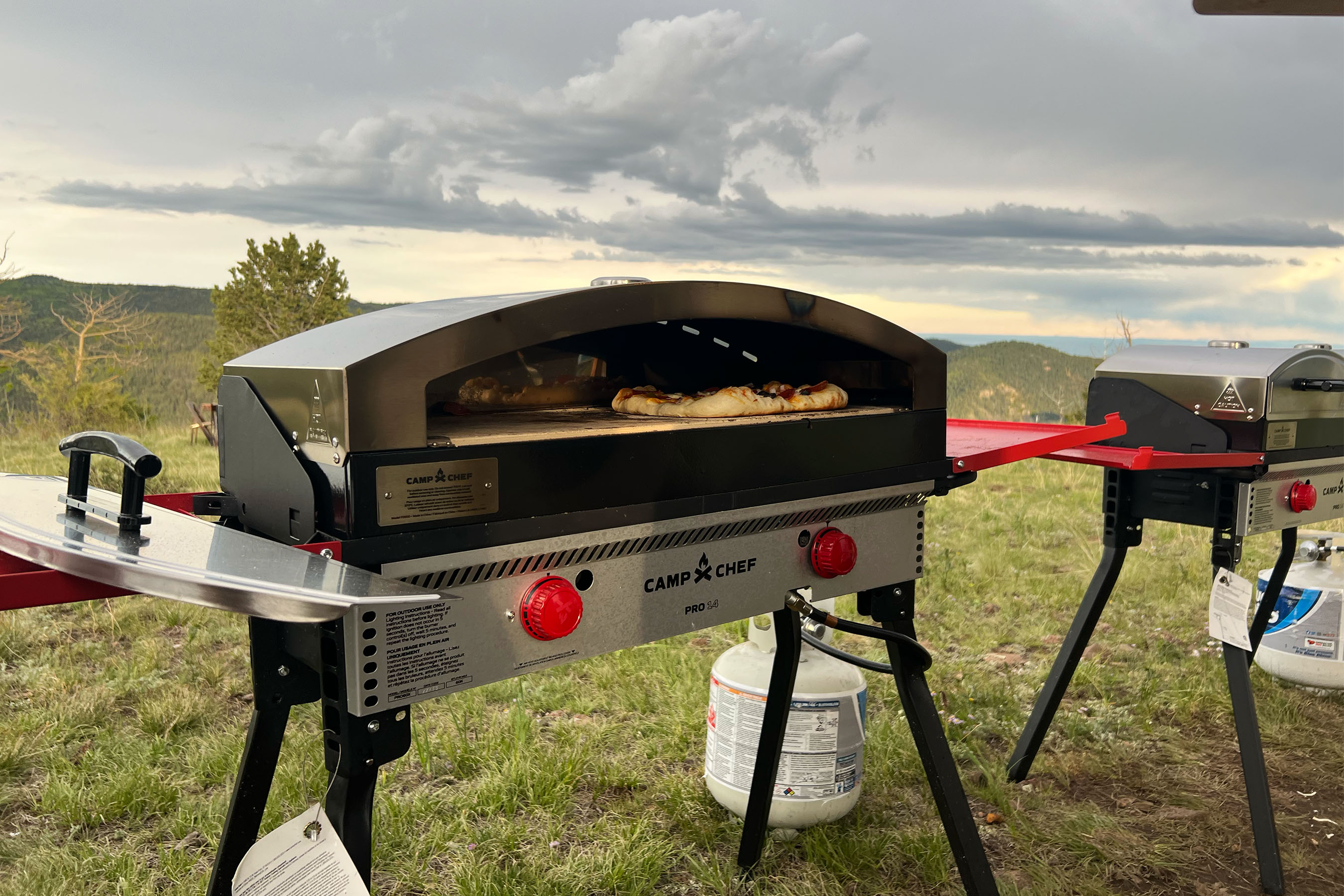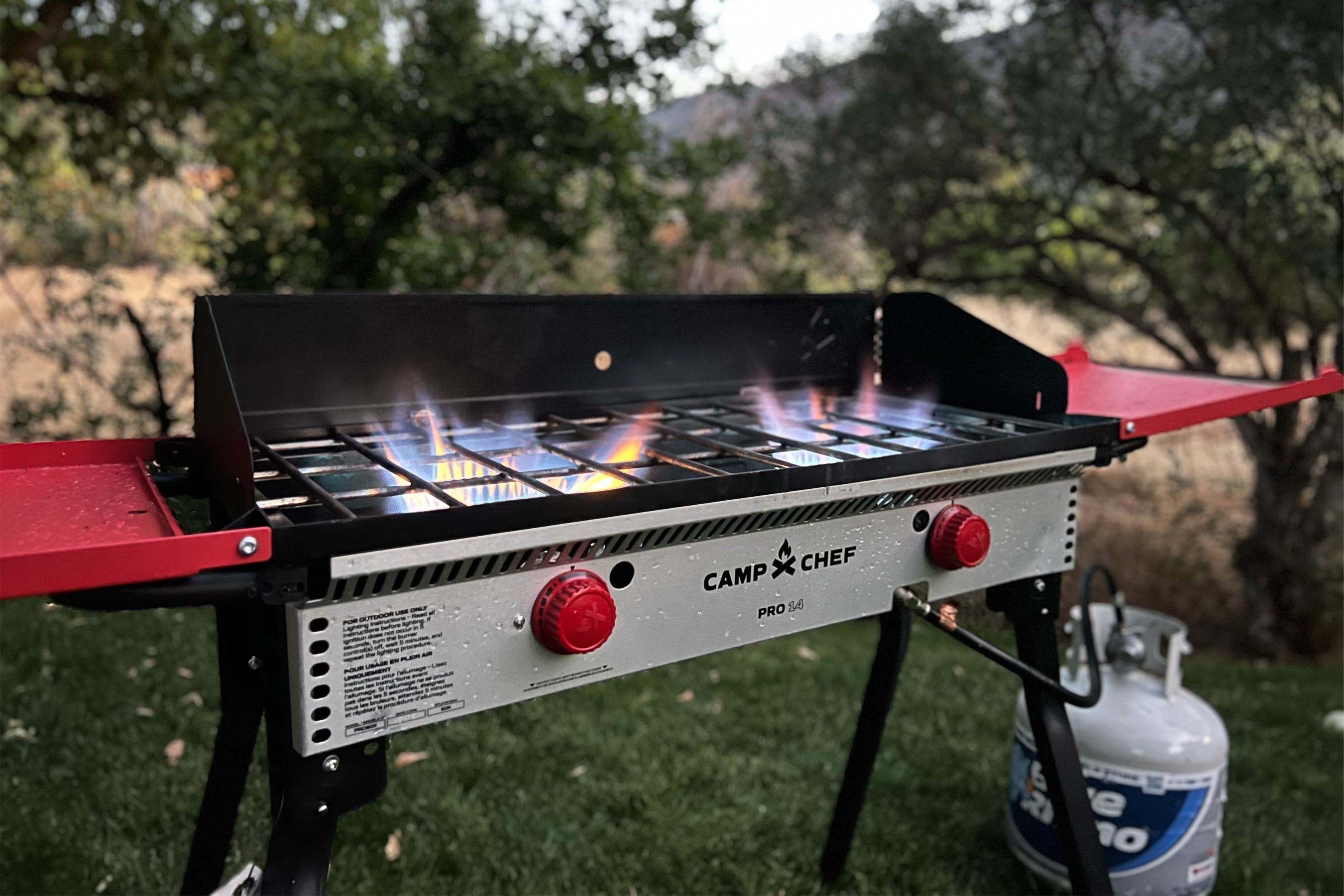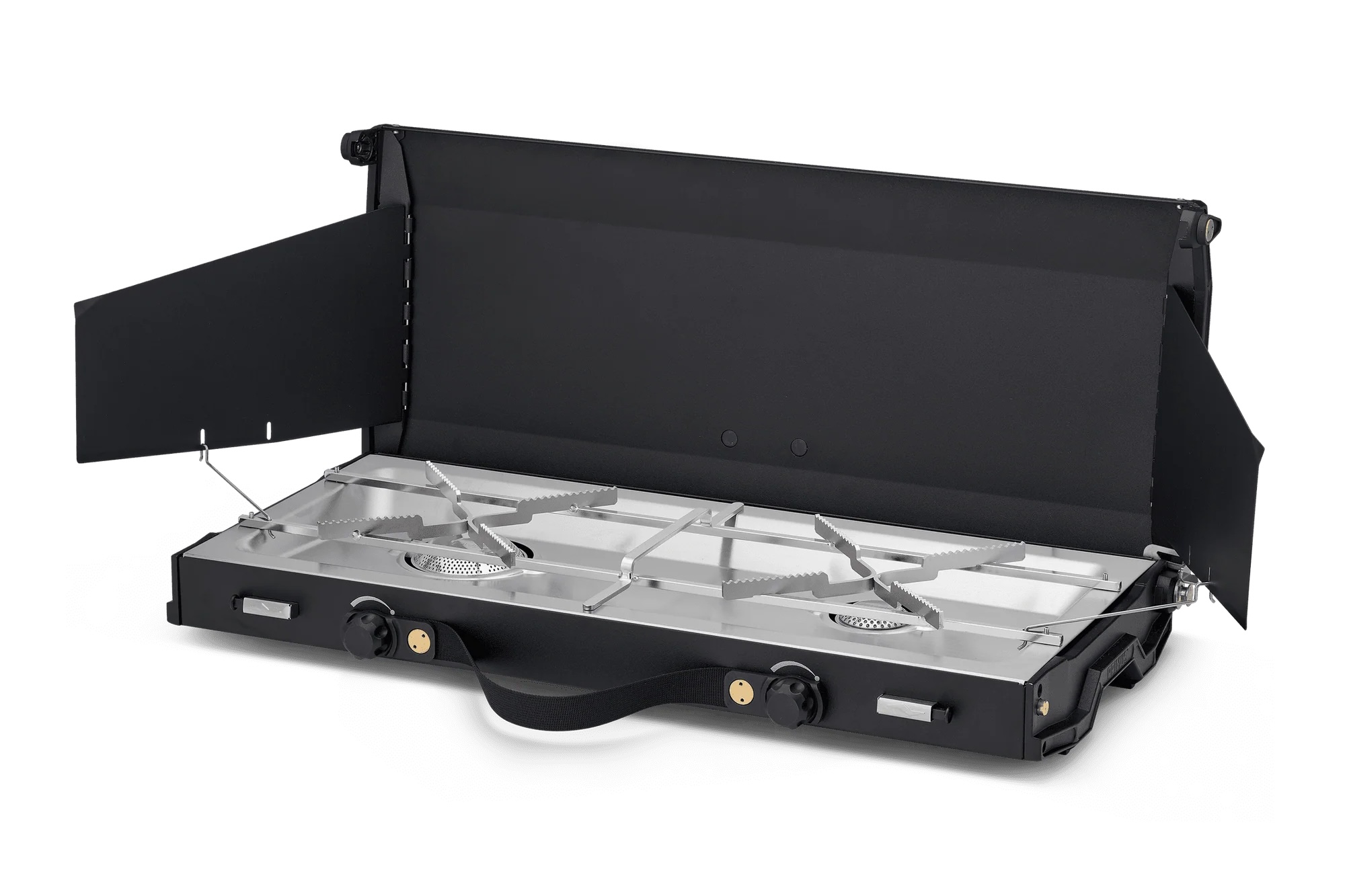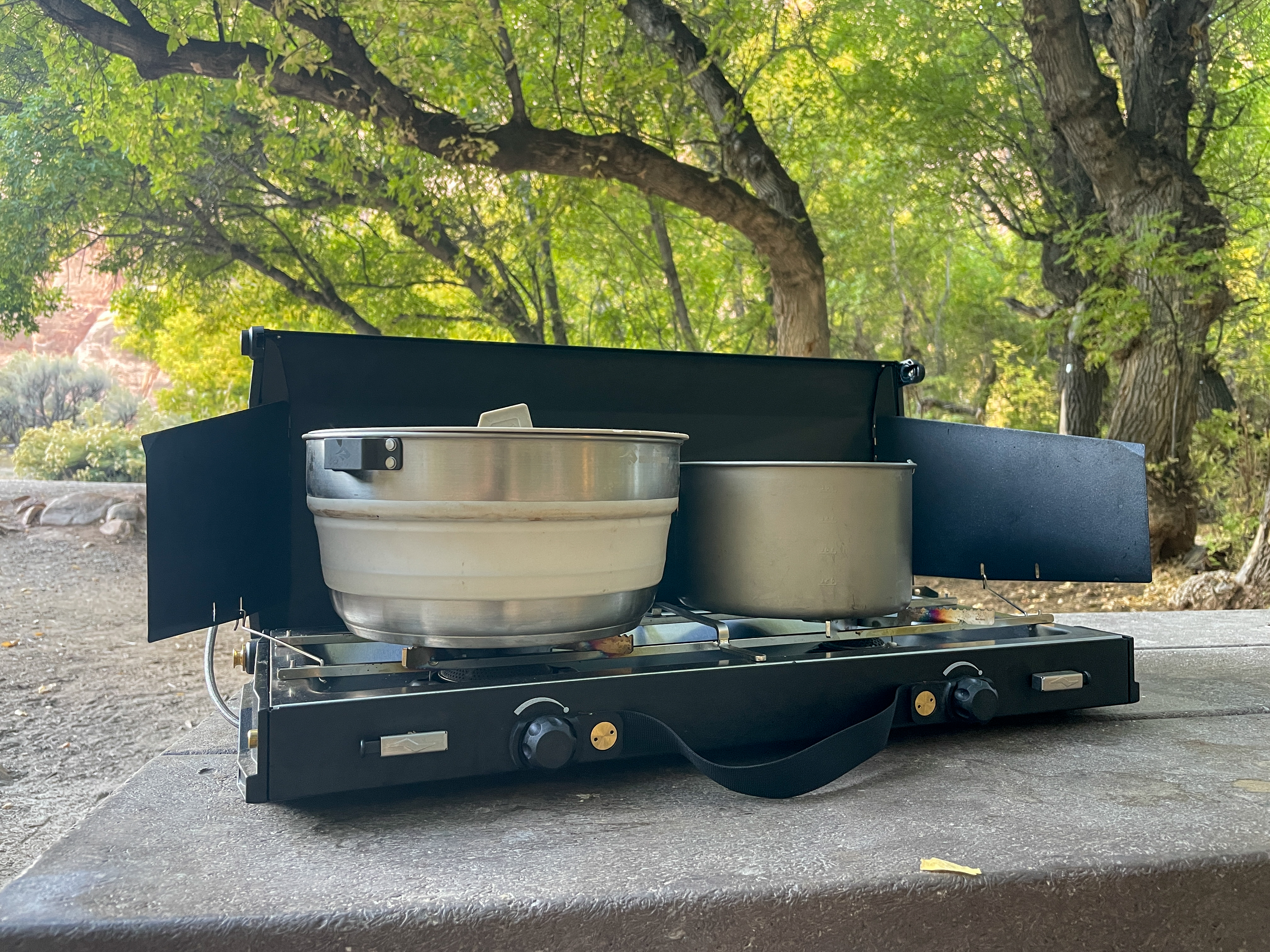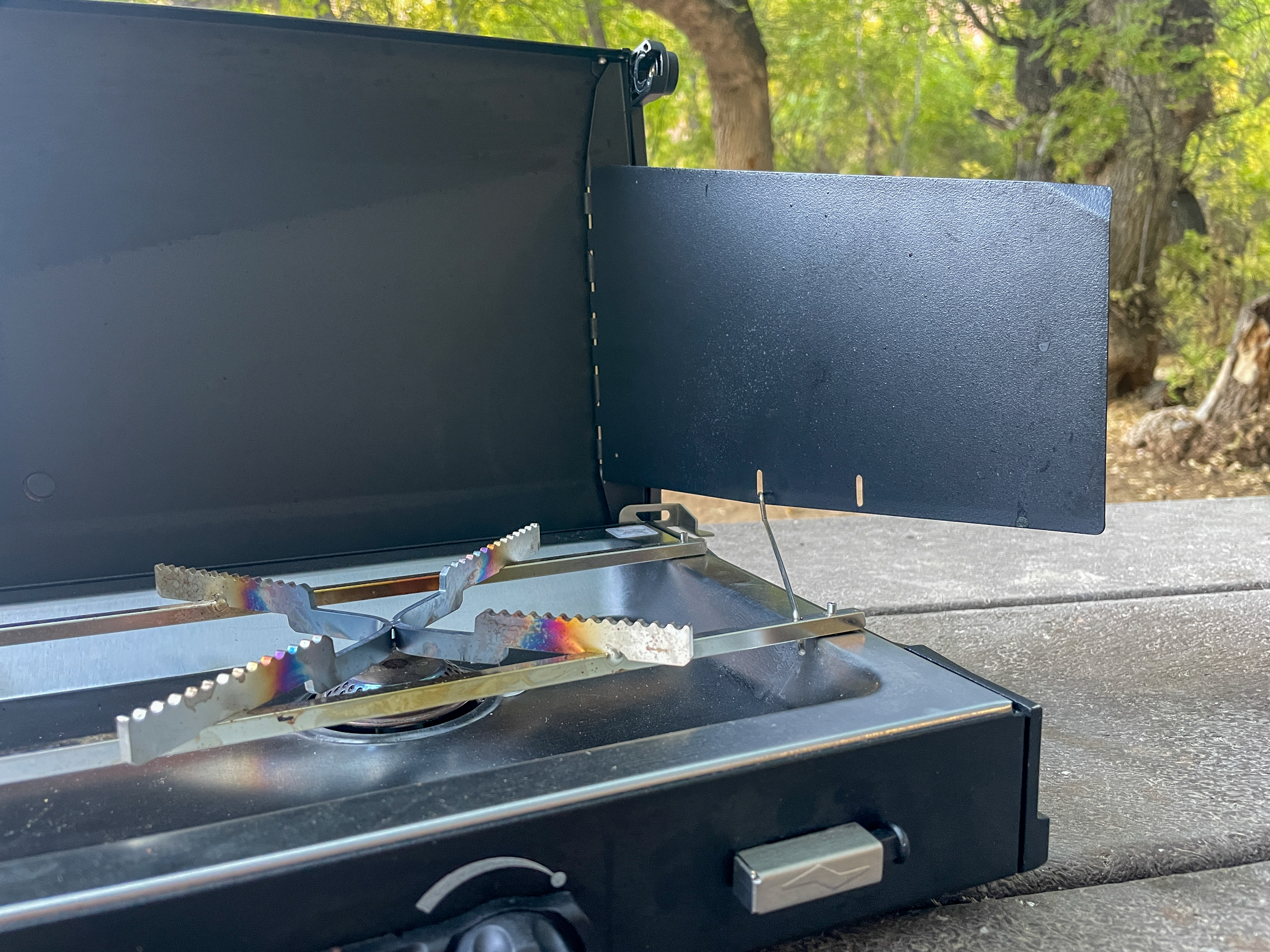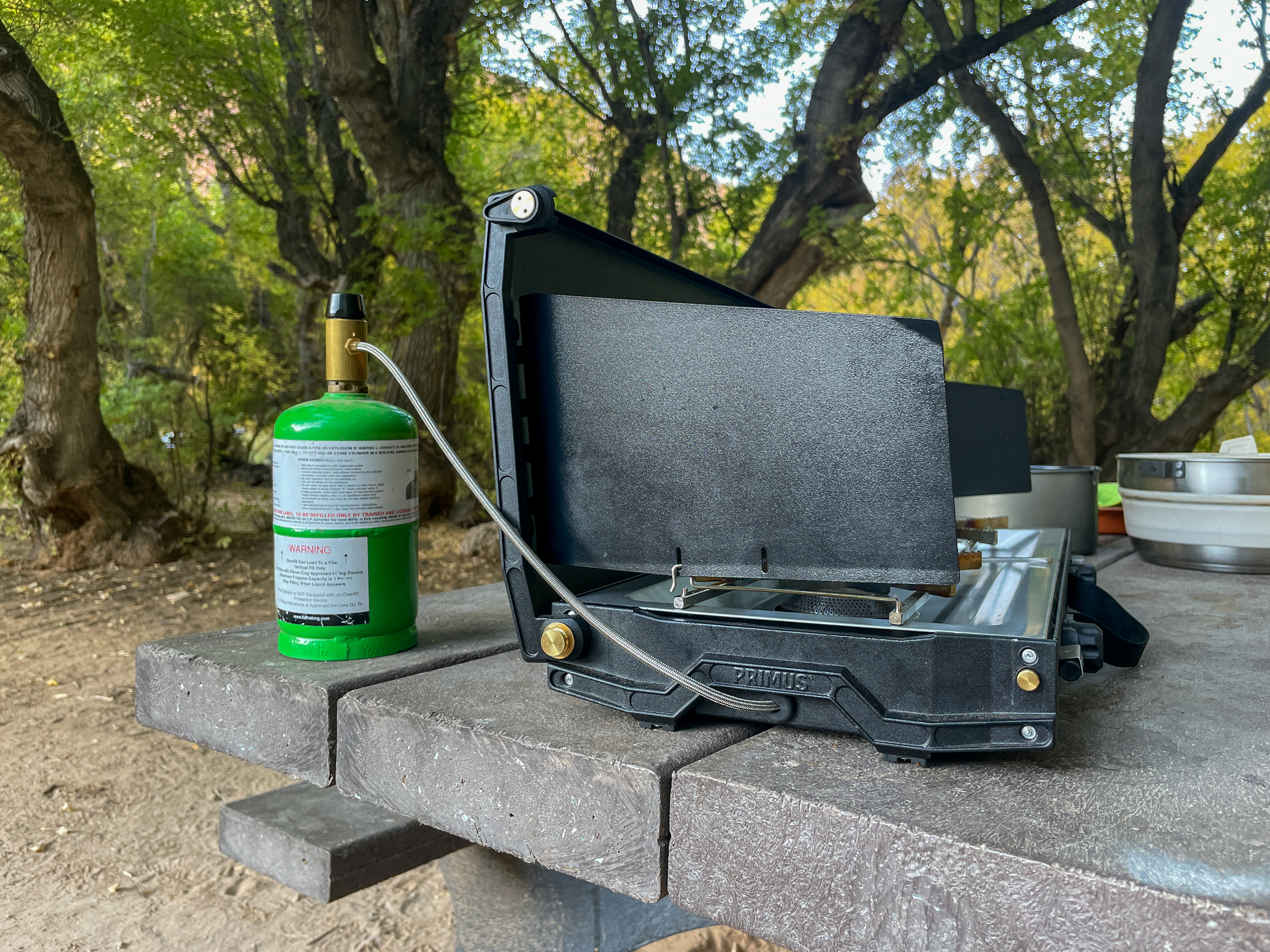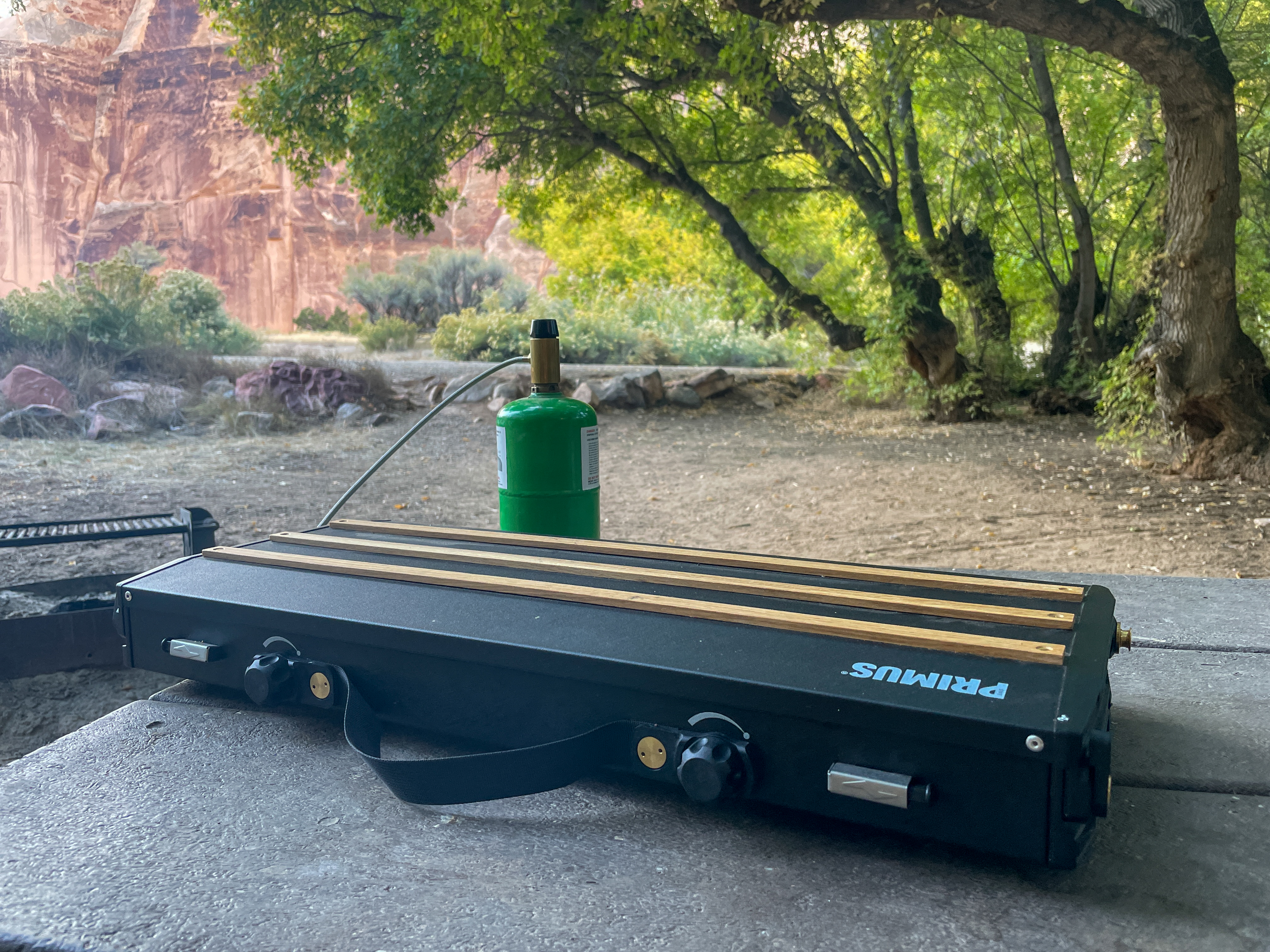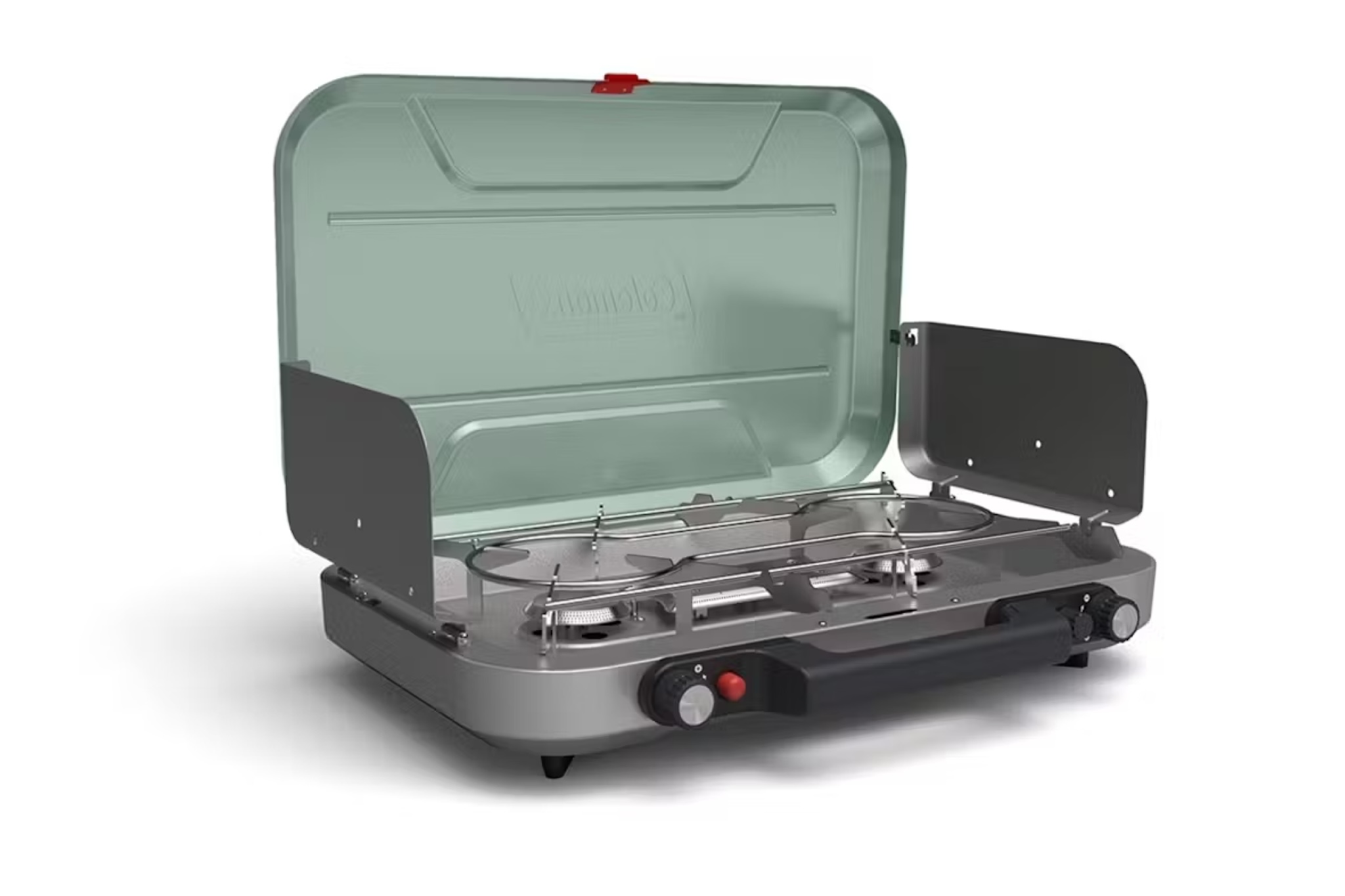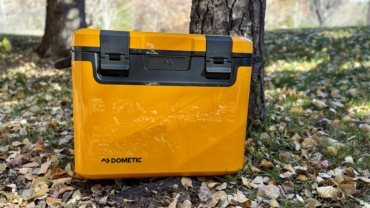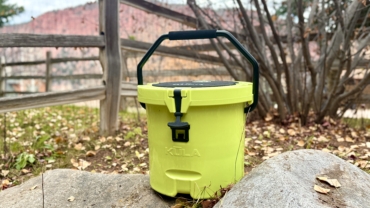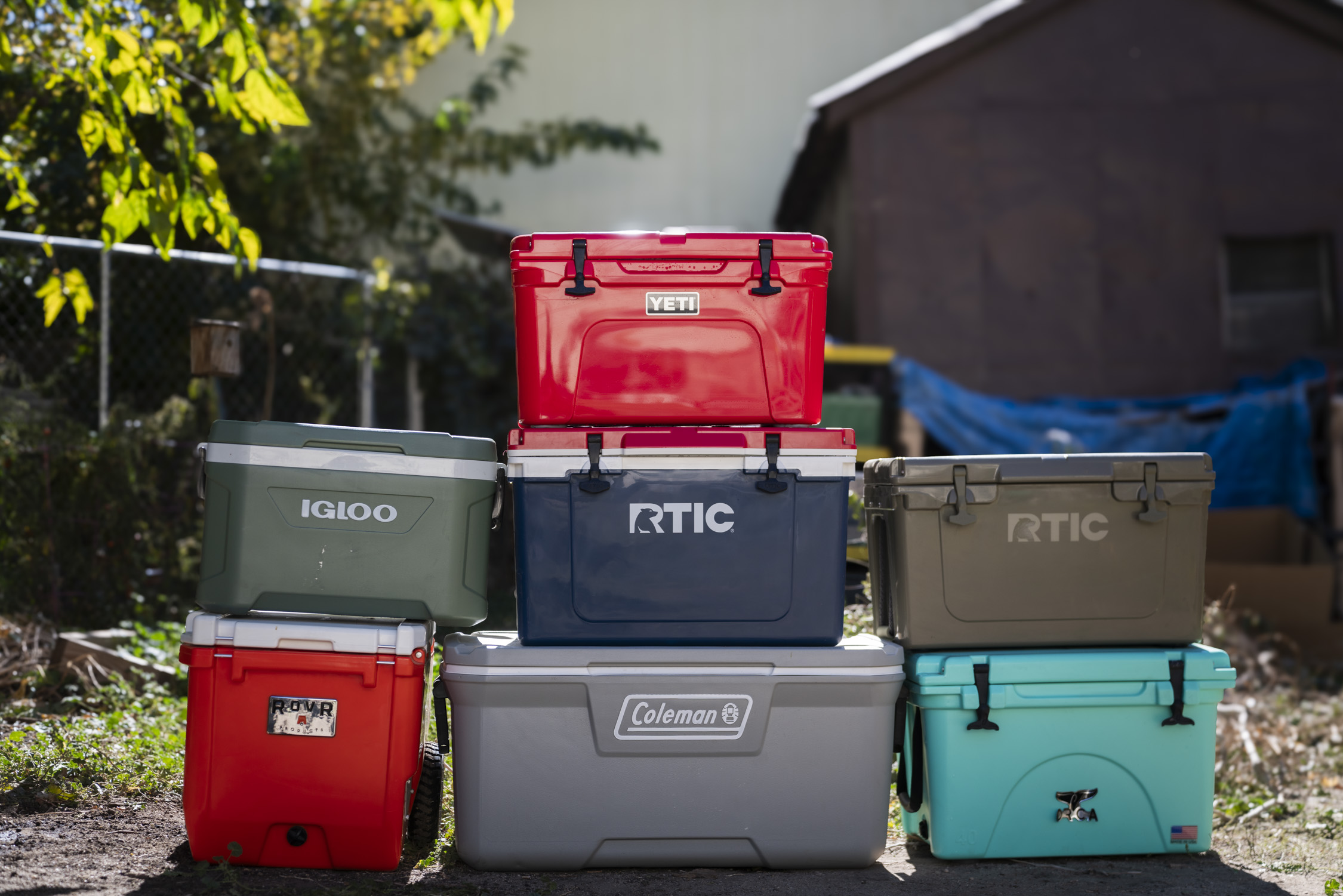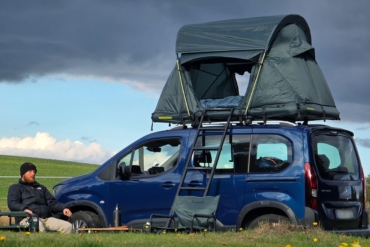Camping and food go hand in hand, especially when car camping affords you the luxury of a two-burner stove. And when good grub is on the line, not just any stove will do. That’s why we’ve been testing the best camping stoves for multiple seasons in a row, and have fired up nearly 25 different options in our quest.
A good camp stove should fire up quickly, provide steady heat to get things rolling, and be able to dial it back for precision work. My top pick, the Camp Chef Everest 2X, has plenty of firepower to keep dishes rolling off the line, but you don’t need to spend the big bucks, either, with the budget Coleman Cascade Classic only running $100.
With years of combined experience with camp cooking, we used our collective knowledge to narrow down the best options today. For each stove in this review, we considered design, ease of use, BTUs, windy weather performance, simmer control, weight, cost, and boil time. On the surface, these stoves all have a lot in common, but each has unique features that stand out for specific uses.
If you’re still unsure which kind of camping stove is right for you, check out our Explainer Series article: How to Choose a Camp Stove.
Editor’s Note: We updated our Camping Stoves buyer’s guide on August 29, 2025 to add the Camp Chef Pro 14 as our new favorite option for cooking for large groups and families. We also added new Rating Attributes to each stove we’ve tested, allowing you to compare and contrast them before making your purchase.
The Best Camping Stoves of 2025
Camp Chef Everest 2X
-
Heat Output
9.0
-
Simmer Control
8.0
-
Wind Protection
8.0
-
Construction
8.0
- Number of Burners: 2
- BTU Output: 20,000-BTU per burner
- Boil Time: 3:06 min. per L
- Fuel Type: Propane
- Weight: 12 lbs.
Pros
- Produces strong flames
- Works well in windy conditions
- Burner design evenly spreads out heat
- Windscreen tabs stay secure with exterior locks, which is a nice touch
Cons
- A bit heavier (12 lbs.) and bulkier than we'd like
Coleman Cascade Classic Camp Stove
-
Heat Output
7.0
-
Simmer Control
6.0
-
Wind Protection
7.0
-
Construction
7.0
- Number of Burners: Two
- BTU Output: 10,000-BTU per burner
- Boil Time: 7:00 min. per L
- Fuel Type: Propane
- Weight: 11 lbs., 14.4 oz.
Pros
- Budget-friendly
- Durable enough for the outdoors
- Ease of use
Cons
- Regulator control knobs could be better
Primus Kinjia
-
Heat Output
7.0
-
Simmer Control
8.0
-
Wind Protection
6.0
-
Contruction
8.0
- Number of Burners: Two
- BTU Output: 10,200 BTUs per burner
- Boil Time: 6:40 min. per L
- Fuel Type: Propane
- Weight: 8 lbs., 3.2 oz.
Pros
- Compact packed size slides into tight storage spots
- Fine simmer control
- Black, brass, and wood details make for a classy look
Cons
- No windscreens
- Gas bottle stand is easy to misplace
Camp Chef Mountaineer
-
Heat Output
9.0
-
Simmer Control
7.0
-
Wind Protection
7.0
-
Construction
9.0
- Number of Burners: Two
- BTU Output: 20,000 BTUs per burner
- Boil Time: 3:25 min. per L
- Fuel Type: Propane
- Weight: 16 lbs.
Pros
- All-aluminum build
- Broad 302 sq. in. cooking surface
- Add-on leg system makes the stove fully freestanding
- Plenty of heat with twin 20K burners
Cons
- Higher price
- Adapter needed to run 1 lb. propane bottles
iKamper Disco Series Camping Grill
-
Heat Output
6.0
-
Simmer Ability
8.0
-
Wind Protection
6.0
-
Construction
9.0
- Number of Burners: One
- BTU Output: 8,455 BTU
- Boil Time: 7:00 min. per L
- Fuel Type: Isobutane
- Weight: 27 lbs.
Pros
- All-in-one modular cooking system
- Kovea-made burner head
- Easy-to-clean enameled cast iron skillet
- Campfire-tripod cooking mode
- Burly anodized aluminum leg system
Cons
- On the heavier side
- Pricey
Snow Peak Home & Camp Burner
-
Heat Output
6.0
-
Simmer Control
8.0
-
Wind Protection
6.0
-
Construction
8.0
- Number of Burners: One
- BTU Output: 8,333-BTU
- Boil Time: 4:00 min. per L
- Fuel Type: Butane
- Weight: 3 lbs.
Pros
- The legs and burner are low to the ground, reducing wind interference
- Great simmer control
- Highly responsive dials
Cons
- On the pricier side ($120) for only one burner
- Butane fuel can be less universal than propane
Camp Chef Pro 14
-
Heat Output
9.0
-
Simmer Control
7.0
-
Wind Protection
7.0
-
Construction
9.0
- Number of Burners: Two
- BTU Output: 30,000 BTU
- Boil Time: 2:50 per liter
- Fuel Type: Propane
- Weight: 48.5 lbs.
Pros
- Lots of cook space
- Powerful burners heat things up quickly
- Portable
- Compatible with host of accessories
Cons
- Heavy
- Takes up car space
- Tricky to clean
- Vulnerable to high winds
Other Camp Stoves to Get Cooking On
We’ve been testing and cooking on camp stoves for nigh decades now, and while the seven award winners above are my top picks for almost any situation outdoors, there are plenty of others on the market that’ll get it done. Consider the eight options below as excellent alternatives that we’ve vetted and would stand behind any day.
-
Heat Output
7.0
-
Simmer Control
8.0
-
Wind Protection
7.0
-
Construction
8.0
- Number of Burners: 2
- BTU Output: 10,000 and 13,300
- Boil Time: 4 min. 30 sec. per L
- Fuel Type: Propane
- Weight: 10 lbs., 6 oz.
Pros
- Compact
- Fine simmer control
- Flexible fuel hose
- Removable lid
- Sleek looks
- Easy to clean
Cons
- Could use better windscreen latches
- Igniters are finicky
- Pricey
-
Heat Output
8.0
-
Simmer Control
7.0
-
Wind Protection
7.0
-
Construction
7.0
- Number of Burners: 3
- BTU Output: 28,000 total, all burners combined
- Boil Time: 7:00 min. per L
- Fuel Type: Propane
- Weight: 18 lbs.
Pros
- Three burners for multiple dishes
- Good simmer control
- Can hold larger pans
- Good in wind
Cons
- Bulky packed size
- Rattles during transport
- More expensive than most stoves
-
Heat Output
7.0
-
Simmer Control
7.0
-
Wind Protection
6.0
-
Construction
7.0
- Number of Burners: Two
- BTU Output: 14,000 BTUs per burner
- Boil Time: 4:25 min. per L
- Fuel Type: Propane
- Weight: 10 lbs.
Pros
- Slim collapsed profile
- Easy-to-clean cook area
- Updated burners put out 14,000 BTUs
Cons
- Not the best wind resistance
-
Heat Output
8.0
-
Simmer Control
7.0
-
Wind Protection
6.0
-
Construction
8.0
- Number of Burners: Two
- BTU Output: 12,000 BTUs per burner
- Boil Time: 4:30 min. per L
- Fuel Type: Propane
- Weight: 13 lbs., 8 oz. (21 lbs., 8 oz. with cast iron griddles)
Pros
- Hotter than average burners
- Quality fit and finish across the stove
- Very versatile with the cast iron cooking surfaces
- Deep carry handle
Cons
- We wish the windscreens were slightly taller
- Pretty hefty with included cast iron attachments
-
Heat Output
8.0
-
Simmer Control
4.0
-
Wind Protection
7.0
-
Construction
8.0
- Number of Burners: One
- BTU Output: 18,000 BTUs
- Boil Time: N/A
- Fuel Type: Propane
- Weight: 24 lbs.
Pros
- Even cooking surface
- Great option when cooking for large groups of people
- You don't need additional pans
Cons
- It takes a while to heat up fully
- Can't boil
- Weighs a hefty 24 lbs.
-
Heat Output
7.0
-
Simmer Control
7.0
-
Wind Protection
6.0
-
Construction
7.0
- Number of Burners: Two
- BTU Output: 10,000-BTU per burner
- Boil Time: 5:45 min. per L
- Fuel Type: Propane
- Weight: 6 lbs., 3 oz.
Pros
- The clamshell folds down small
- Great simmering control
- Includes pot and pan
- Can chain additional burners
Cons
- More expensive than other stoves on the list
- Hi-tech, modern look isn't for everybody
Camping Stove Comparison Chart
| Camping Stove | Price | Burners | BTU Output | Boil Time | Fuel Type | Weight |
|---|---|---|---|---|---|---|
| Camp Chef Everest 2X | $230 | Two | 20,000-BTU per burner | 3:06 min. per L | Propane | 12 lbs. |
| Coleman Cascade Classic Camp Stove | $130 | Two | 10,000-BTU per burner | 7:00 min. per L | Propane | 11 lb., 14.4 oz. |
| Primus Kinjia | $230 | Two | 10,200-BTU per burner | 6:40 min. per L | Propane | 8 lbs., 3.2 oz. |
| Camp Chef Mountaineer | $470 | Two | 20,000-BTU per burner | 3:25 min. per L | Propane | 16 lbs. |
| iKamper Disco Series Camping Grill | $515 | One | 8,455 BTU | 7:00 min. per L | Iso-butane | 27 lbs. |
| Snow Peak Home & Camp Burner | $120 | One | 8,333-BTU | 4:00 min. per L | Butane | 3 lbs. |
| Camp Chef Pro 14 | $380 | Two | 30,000-BTU per burner | 2:50 min. per L | Propane | 48 lbs., 8 oz. |
| Primus Alika | $330 | Two | 10,000 and 13,300 BTUs | 4:30 min. per L | Propane | 10 lbs., 6 oz. |
| Coleman Cascade 328 | $260 | Three | 28,000-BTU total | 7:00 min. per L | Propane | 18 lbs. |
| GSI Outdoors Selkirk 540+ | $150 | Two | 14,000-BTU per burner | 4:25 min. per L | Propane | 10 lbs. |
| Coleman 3-in-1 Stove | $275 | Two | 12,000-BTU per burner | 4:30 min. per L | Propane | 13 lbs., 8 oz. |
| Camp Chef VersaTop | $190 | One | 18,000-BTU | N/A | Propane | 24 lbs. |
| Jetboil Genesis Basecamp Stove System | $450 | Two | 10,000-BTU per burner | 5:45 min. per L | Propane | 6 lbs., 3 oz. |

How We Tested the Best Camping Stoves
You wouldn’t head out into the backcountry with an untested backpacking stove, and while the stakes might not be as high while camping, it’ll certainly put a damper on the evening should things fizzle out. Luckily, we’ve done the heavy lifting for you, and thanks to our crew of outdoors enthusiasts, we’ve field-tested the entire spectrum of camp stoves, from compact single burners to brew up your coffee to full-blown mobile kitchens that’ll feed 10 people with ease.
Our Expert Testers
Guide author Mary Murphy is a multisport athlete, and it wouldn’t be off-base to claim that camp cooking is also one of those sports. From her outpost in Denver, she assembled our initial slate of 12 camp stoves in 2021 and dreamed up our boiling and simmering testing regimen to ensure each stove was tested on an even playing field.
I, Senior Editor Nick Belcaster, have experienced the entire backcountry culinary spectrum, from cold-soaking ramen noodles on months-long thru-hikes to whipping up full-course meals for groups of friends while car camping, and my time on the hot side has earned him the title of honorary grill master among camping compadres. Based in Washington state, I continue to test the latest and greatest in camp stoves on forays into the mountains and out to the coast — typically in something a bit more casual than chef’s whites.
Our Testing Process
Besides just boiling water, we cooked meals on each of the camp stoves for this review (including mac and cheese, sautéed veggies, meats, rice, and more). I also conducted boil and simmer tests — both with and without a manufactured wind blowing — which are a consistent way of comparing stove performance. I believe this provides a good understanding of each stove’s technical cooking capabilities. And finally, as the green canisters started to pile up, I tallied our fuel consumption to figure out the relative efficiency of each stove.
When I test a camp stove, I’m also looking at the big picture, and pay special attention to functional differences in ease of use, packability, weight, and availability of fueling. All told, our team has put close to 25 different stove systems through our ringer, and have come up with a pretty good understanding of what makes a great camp stove the center of your outdoor kitchen.

Boil and Simmer Tests
I subjected each propane stove to a substantial boil test. I boiled 1 L of water with the same GSI pot and lid on each stove. Before each test, I made sure the pot and water were at the same temperatures as in prior tests. I also checked the water occasionally to note when it began to boil.
Different air temperatures and altitudes will boil water differently, so I tested all of these stoves at the same altitude. Don’t buy one of these stoves and expect it to boil water at these specific times; instead, use this as a rough guide as to which stove heats the most effectively and gets the hottest. Some stoves might have faster boiling times, and others might have better simmer capabilities.
Simmer Test
To test how well a stove could simmer, I tested the knobs and saw how low the flame could go while still remaining active. I also placed a hand above the flame and lowered it to see how close we could get before it got uncomfortable.
The closer the hand could comfortably get (measured in inches), the lower I found a burner could go. Why does this matter? You don’t just want a stove to have hot and very hot settings; sometimes, you need less flame to cook on a low simmer.
I also tested each of the dials to see the range of control they allowed. The higher the degrees of rotation, the more you can turn the dial and change the heat output.
Generally, the higher, the better, as this lets you clearly know if you’re cooking on low, medium, or high. The highest were the Jetboil Genesis and Primus Alika, with 1440 and 1300, respectively, while a few only went 180, including the Camp Chef Pro 14.

| Camping Stove | Time to Boil 1 Liter | Simmer Test |
|---|---|---|
| Camp Chef Pro 14 | 2:50 minutes per L | 3 inches, 180 degrees |
| Camp Chef Everest 2X | 3:06 minutes per L | 1 inch, 360+ degrees |
| Camp Chef Mountaineer | 3:25 minutes per L | 1 inch, 360+ degrees |
| Snow Peak Home & Camp Burner | 4:00 minutes per L | 2 inches, 3 settings |
| GSI Outdoors Selkirk 540+ | 4:25 minutes per L | 4 inches, 720 degrees |
| Primus Alika | 4:30 minutes per L | 1 inch, 360 degrees |
| Coleman 3-in-1 | 4:30 minutes per L | 2 inches, 360 degrees |
| Jetboil Genesis Basecamp Stove | 5:45 minutes per L | 2 inches, 1,440 degrees |
| Primus Kinjia | 6:40 minutes per L | 2 inches, 360 degrees |
| Coleman Cascade 328 | 7:00 minutes per L | 1 inch, 830 degrees |
| iKamper Disco Series Camping Grill | 7:00 minutes per L | 1 inch, 270 degrees |
| Coleman Cascade Classic | 7:00 minutes per L | 2-3 inches, 270 degrees |
Buyer’s Guide: How to Choose a Camping Stove
This list is for car camping stoves. If you want to eat hot food while hiking or backpacking, check out our review of the best backpacking stoves. Or, if a good char is your thing, take a look at our gear guide of the best portable grills. Otherwise, read on as I break down the nitty-gritty details of camping stoves.
While the camp stove might be the centerpiece of your camp kitchen, its not alone, and building out your perfect camp kitchen will require assembling the proper cook and tableware, utensils, furniture, and organizers. Check out our article on Dialing in Your Camp Kitchen for more details.
Types of Camping Stoves: Standalone Remote Fuel or Freestanding

Camping stoves can be broken down into two main groups, and deciding what kind of camp cooking you’re aiming to do will help you narrow down which stove is better for you. The vast majority of camp stoves are stand-alone, remote fuel stoves, which differentiate themselves from backpacking stoves by not relying on the canister to support the stove. Weighing right around 10 pounds and packing down efficiently to be stowed away, these stoves are best placed on a camp or picnic table, with their outboard fuel canisters supported.
Freestanding stoves, on the other hand, are large group cookers and totally self-supporting. They have adjustable legs that make them easier to stand at while using, but also bulkier and harder to move around. These models typically have higher outputs to handle boiling large pots for things like crab boils or stews, and the 30,000 BTU Camp Chef Pro 14 is an excellent example. Freestanding stoves typically are fueled by the larger 20-pound propane canisters or can be used with smaller refillable canisters like the Ignik 5-pound Gas Growler.
Number of Burners

If you spend more than 2-3 months out of the year camping — even if you are a single household — I’d recommend going for a two-burner camping stove. Two burners mean you always have the option of cooking with a pot and pan or, for instance, making one entrée alongside a vegetarian or kid-friendly option, and you avoid the musical chairs of attempting to have everything hot at the same time.
Not to mention, two-burner stoves are the standard. However, for those wanting something different, there are now many single-burner (and even a few three-burner, like the Coleman Cascade 328) options on the market. For larger groups, consider a three-burner such as the Camp Chef Pro 16, which sports 30,000 BTUs across the cooking surface.
Another easy way to augment the number of burners available is to add a single-burner type stove, like the Snow Peak Home & Camp Burner, into the mix. I’ve often utilized combos like this to churn out pasta and sauce, while my sous chef whips up a hot side.
Chainable stove systems like the Jetboil Genesis Basecamp are another excellent way to add additional cooking surfaces and reduce the number of propane bottles you need to carry. Compared to bigger three-burner units, the beauty of a chainable system is that you can leave components behind if you’re going solo or don’t need to cook that much.
BTUs Explained

BTU stands for British Thermal Unit. Basically, it’s a measurement of energy and, in the case of camp stoves, heat. A gas range stove you’d find in a home has about 6,000-8,000 BTUs per burner (on average), and for the curious, a single BTU is the amount of energy needed to raise the temperature of 1 pound of water by 1 degree Fahrenheit.
Lower BTUs generally mean lower-heat cooking (good for simmering and light cooking uses). Higher BTUs (anything above 10,000) indicate high-heat cooking (great for meals with longer cook times and essential for boiling lots of water quickly). The flame pattern that a burner head puts out will also affect heat transfer, but BTUs are a relatively clean way to compare stoves.
Most camp stoves today produce around 10,000 BTU, which is a perfectly functional amount of heat for almost all cooking purposes. This balances fuel efficiency well and will still boil a pot of water in a reasonable amount of time. Stoves like the Coleman Cascade Classic, Primus Kinjia, and Eureka Ingite all produce around this amount and worked admirably in our testing.
Bumping up the BTUs can certainly speed up the cooking process, especially when it comes to bringing water to a boil. The GSI Selkirk 540+ and Coleman 3-in-1 both pump out around 12-14,000 BTU, and were able to bring a liter of water to a boil in less than 4 minutes and 30 seconds.
This increase in performance does come with a cost, however, and in high-performance 20,000 BTU stoves like the Camp Chef Everest 2X, fuel consumption will take a hit. Consider bringing along multiple gas canisters when cooking with these higher-power options.
Time to Boil

Usually, when you go camping, you’re there to enjoy the outdoors. And yes, that also means enjoying hanging around camp and eating good camp food. One of the most essential criteria for a camp stove is its ability to boil water.
Some stoves can boil in 3 minutes, while others take as long as 10 minutes. The stove that boils the fastest marks a great stove, but doesn’t necessarily make it the best. If you are looking for certain features, say a lightweight stove or one with an igniter, you may have to sacrifice some boil time.
In my testing, it was no surprise that the 30,000 BTU powerhouse Camp Chef Pro 14 was hot to trot right out of the gate and boiled a liter of water in less than 3 minutes. Following that were the higher-end BTU stoves, including the Camp Chef Everest 2X, the Camp Chef Mountaineer, and the Coleman 3-in-1.
Interestingly, the glut of stoves with around 10,000-12,000 BTU shook out with a wide variance of times, and can likely be attributed to their burner size and shape. Bringing up the rear was the budget Coleman Cascade Classic, which took a full 7 minutes to boil.
All the stoves I reviewed were able to efficiently light/start, heat, and reach a rolling boil in 8 minutes or less.
Simmer Control and Flame Pattern

I did a whole test on simmer control because, as I’ve mentioned, boiling water isn’t everything. In order to enjoy a good chef-quality camp meal, you want to be able to boil, but also bake, sauté, fry, simmer, grill, and more. I measured the simmering range on the flame of each burner/stove to see how they stacked up.
The pattern of the flame that the burner head puts out also has a good bit to do with how well a stove will simmer. Small burners like those present on the Primus Kinjia concentrate the heat in one area, and you’ll need to continue stirring to keep food from burning, or use cookware that dissipates heat, such as cast iron. This was one of the reasons I loved the Camp Chef Everest 2X so much, which has broad burner heads that distribute heat evenly and make for fuss-free simmering.
Performance in Wind

Think about how often and under what conditions (such as in cold weather) you’ll be using your stove. The more you expand your horizons to travel, the more likely you are to encounter harsh weather and wind. Knowing whether or not your stove can hold up in windy weather isn’t something you want to learn on a 10-day camping trip on the blustery New England coast.
Camp stoves aim to protect themselves from the wind in three ways. The first is windscreens, which are typically attached to the lid of the stove and are deployed by folding them out. This creates a three-sided barrier from gusts that might otherwise attempt to snuff out your flame. Windscreens aren’t often very adjustable, so you’ll want to aim your stove with the lid pointing into the wind.
The second method of blocking wind is recessing the burners into the stove pan. This is fairly prominent on stoves like the Primus Kinjia or Coleman Cascade Classic but noticeably absent on the GSI Selkirk 540+, which likely contributed to that stove’s lesser ability to avoid being blown out. The final barrier against wind is only seen on the Camp Chef Everest 2X, and those are small metal dishes that surround each burner. These made the Everest extremely resistant to being blown out.
If you live somewhere windy, you can also ensure better stove performance in wind and cold by investing in more BTUs.
Fuel Types, Capacities, and Efficiency

The majority of stoves on this list use 1-pound propane canisters. However, a few, like the Snow Peak Home & Camp, use butane fuel, and the Primus Alika and iKamper Disco can use both. While it varies based on how long you take to cook your meals and what setting your burner is on, a 1-pound propane canister generally lasts about three or four meals, or about 1 hour of cooking time. If you’re headed out for a weekend, I recommend packing a few canisters, as multiple meals can start to chew through them.
Propane is generally considered an all-weather cooking fuel, but it will start to get finicky as the temperatures drop. You can help safeguard against this by keeping your canisters in a warm place before cooking and tucking them back away when you’re done. Butane, on the other hand, doesn’t do so well in the cold, and I don’t generally recommend it for shoulder-season cooking.
In testing, I timed each stove for how long it would run on a single 16-ounce propane canister and found that, in general, the higher the BTUs, the thirstier the stove and the quicker it would burn fuel. At full-blast the Camp Chef Everest 2X will always find the bottom of a canister before the 10,000 BTU stoves, and because of this I always recommend only running your stove as hot as you need to cook on.
While traditional 1-pound propane canisters are single-use, you may consider investing in a refillable propane tank like the Gas Growler from Ignik ($150), which will allow you to refill your camp canister from 20-pound propane tanks. This can greatly simplify your camp cooking needs and keep disposable tanks out of the landfill.
Or, if space is at a premium, the Flame King 1-pound refillable bottles offer the same convenience, at the same size as the single-use tanks. Take note that generally all camp stoves use a screw-on adapter that accepts 16-ounce canisters, but adapters can be purchased for running off bigger tanks.
Weight and Packed Size
Weight is one of the biggest differentiators between the stoves on this list. However, these stoves are built for car camping, so you won’t really be carrying them too far. If you know you want a capable and strong two-burner, weight might not matter as much as other features.
What matters more is the packed size. There’s only so much space in your car or truck or at your campsite, so compact stoves like the Jetboil Genesis Basecamp Stove or the Primus Kinjia can make a difference.
Check to see if the stove packs down into a case, has a cover, and how the fuel line and grill can be stored. Is it all stored together? Do accessories take up more space? These are all factors to consider for your unique preferences and needs.
Ignition: Strikers vs. Matches

Strikers, also sometimes known as auto-igniters or piezo igniters, are buttons that expel a spark using electricity to ignite a stove. (It’s a process similar to the button that ignites the pilot light on your stove at home.)
Over the years, I’ve had the pleasure of using some high-quality piezo igniters and felt the sadness of realizing that the built-in striker has bit the dust. Know that different qualities of piezo igniters exist, and that generally, you get what you pay for.
Other strikers that provide a spark can be flint or metal. I always opt for a camp stove that has an integrated igniter — as long as the igniter works consistently, this is the best option.
The last option for lighting your camp stove is the good ol’-fashioned match. However, matches can be wasteful and fragile, and not all are waterproof or can stand up to harsh weather. You can always bring flint or some matches as a backup method.
Extra Features: Griddles, Grates, Pots, and More

Think about who you’re cooking for. Is your group size usually one to two people, three to four, or a larger family? Also, consider what you’re cooking.
Do you make a lot of one-pot meals, or do you like sautéing, simmering, slicing, dicing, and baking when outdoors? Do you want to invest in these features down the road? Or do you want a stove with a compatible grill top, or a stove big enough for say, a dutch oven?
Finally, consider your budget. If you see a stove on sale for less than the others, I recommend jumping on it.
If you need a little more information before making your decision, take a look through our Explainer Series article How to Choose a Camp Stove.
Price & Value

Buy the right one, and a good camping stove can be a bit of a legacy item. But knowing which one is right more often comes down to how often you’ll be using it and what you’re looking to cook on it. From $100 budget burners to $500 specialist units with built-in cast iron, there’s a pretty wide range of options out there.
Budget
If camping is an on-again, off-again endeavor for you (or maybe you just backpack more than you car camp), there are not many reasons to splurge on the nicest stovetop in the campsite. Budget camp stoves will certainly get the job done, and even these options will come with two burners as standard. 10,000 BTUs is common in these frugal units, and you may have to give up the ease of a piezo ignitor. Expect to pay under $100 for these burners.
For a bit more than a C-note, the Coleman Cascade Classic Camp Stove ($130) is a dual-burner that just doesn’t quit in my experience. Yes, the build uses a bit thinner material than other stoves (and it weighs a bit more, somehow), but it’s proven to be a dependable cooker, even despite the budget price.
Mid-Tier
For between $100 and $250, you can get into a camp stove that’ll go the distance and bump up the firepower a bit for dishes that might require shallow frying. Burners of between 15 and 20K BTUs will get you there and are often shielded by better windscreens and set below larger cooking surfaces that can accommodate big frying pans. This is also where some more specialist stoves reside, such as 3-in-1 options with different cooking surfaces.
The Camp Chef Everest 2X ($230) has been our top pick for almost 5 years now, and I’m sticking with it. No other stove has the rugged build quality, 20,000 BTU burners, and reliable piezo ignitor as it does. There are a number of reliable dual-burners that perform just slightly less, however, such as the GSI Outdoors Selkirk 540+ ($150).
Premium
North of $250 are the premium options, which include large camp stoves with integrated legs and dual-burners with novel designs, such as all-aluminum constructions or collapsible configurations. These stoves are certainly investment pieces, but our testing has shown that they’re built to last.
The Camp Chef Pro 14 ($380) is my new stove of choice for feeding large groups, and the two 30,000 BTU burners have more than enough to do it with. The Camp Chef Mountaineer ($470) is everything I love about the Everest 2X — just lightweight aluminum — and if you’ve got the extra dough, I highly recommend it. At the very end of the spectrum, the $500+ iKamper Disco costs a pretty penny but jams in so much cooking ability that its tough to use it all in a weekend.
Frequently Asked Questions
Small can mean compact or, in the case of camp stoves, slimmer and lighter. Each of the stoves on this list is designed with some form of portability and compactness in mind.
If you are tight on space and looking for a truly small stove to stash away in your camp kit or vehicle, I’d recommend the Snow Peak Home & Camp Burner (a one-burner option) or the Primus Kinjia (a slim and more budget-friendly two-burner).
By far, the best stove for families is the one that will fit your family’s needs. That being said, I’d recommend a stove that’s sturdy, versatile (can cook multiple meals), and easy to clean.
You can’t go wrong with any of our top picks, but the Camp Chef Everest 2X stands out for peak cooking performance and durability. The Coleman Cascade Classic Camp Stove, on the other hand, stands out for budget-friendly, simple, and durable use. Both are durable options that should last for years of family gatherings.
Both butane and propane have their pros and cons. Both are pressurized gasses — gas that is compressed and stored as a liquid. Butane tends to perform less well in colder weather. Propane canisters can come in all types of sizes (a better variety to suit a wider range of needs).
It’s important to take note of what climate you’ll be using your camp stove in most. Also, propane is fairly easy to access — you can find it in a big city, in rural towns, even in general stores near state or national parks.
Does the stove have a fuel line adaptor to accommodate different types of fuel? Only a few stoves on the market can run on multiple fuels (Coleman even makes one that runs on gasoline), but the majority are designed for solely butane or propane.
Backpacking stoves are very small single-burner units that can fit in a backpack (even the palm of your hand). Their weight is measured in ounces. Camping stoves, however, are used at “base camp” when you are car camping, truck camping, visiting National Parks, or traveling between.
Camp stoves are bigger and heavier (average 8-14 pounds), and they’re made to be set on a tabletop, truck bed, picnic, or camp table, converting your camp into a camp kitchen.
If you’re looking at the differences between both and are still stumped as to which to choose for your next outing, read up on How to Choose a Camp Stove in our handy guide.
First, consider how you plan on using your camping stove. Someone who is looking to make a near-fixture of their camp stove in a van build-out is likely to have different requirements over someone who only needs to boil water during weekend camping trips. If you are in the first camp, look into your more substantially built stoves, such as the Camp Chef Everest 2X. For more casual use, consider the Coleman Cascade Classic.
Then, think about the types of meals you are looking to brew up. More substantial or complicated meals will require more cooking space, as well as potentially more heat output. Look for a twin burner stove with at least 10,000-BTU output if you’re the camp chef of your friend group. We find the Coleman 3-in-1 to be a versatile stove that is ready for any type of meal.
Finally, consider if you might ever utilize your stove in a hike-in capacity. There are a number of lighter camp stoves on the market, such as the Snow Peak Home & Camp Burner or Jetboil Genesis Basecamp Stove, that make packing them into camp a much easier chore.

The Best Backpacking Stoves of 2025
The right stove makes life on the trail better. From ultralight canisters to four-season and multifuel options, we’ve found and tested the best backpacking stoves.

The Best Camping Tents of 2025
We make finding the right camping tent easier for you by bringing you the best camping tents of 2025. Check out our top picks from REI Co-op, Kelty, NEMO, and more.




